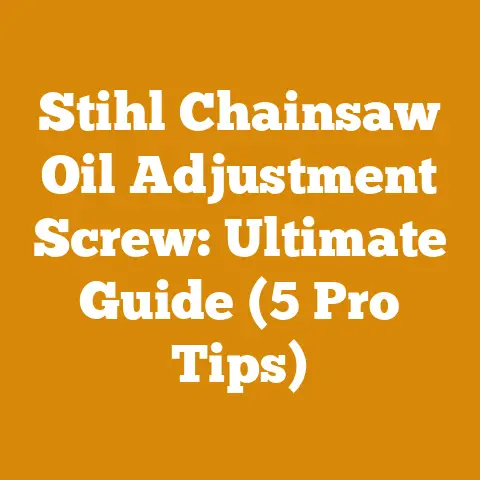Wood Preservative Below Ground: Protecting Ground Contact Lumber (Pro Tips)
Ever had the sinking feeling of realizing your fence post, the one you painstakingly installed, is rotting away at ground level?
Or maybe you’re planning a deck, and the thought of replacing those support beams in just a few years fills you with dread?
I’ve been there.
In fact, I learned this lesson the hard way after building a beautiful raised garden bed.
I used untreated lumber, thinking it would be “close enough.” Big mistake.
Within two seasons, the parts in contact with the soil were mush.
That’s when I dove headfirst into the world of wood preservatives, specifically those designed for below-ground applications.
The global wood preservation market is a significant one, estimated to reach billions of dollars annually.
This highlights the widespread need for effective wood protection, driven by factors like increasing construction activities and the growing demand for durable wood products.
Statistics show that properly treated wood can last significantly longer than untreated wood, often extending its lifespan by decades.
This translates to substantial cost savings in the long run, not to mention the environmental benefits of reducing the need for frequent replacements.
In this guide, I’m going to share everything I’ve learned about protecting ground contact lumber.
We’ll cover the best types of wood preservatives, how to apply them correctly, and some pro tips to ensure your projects stand the test of time.
This isn’t just about slapping on some chemicals; it’s about understanding the science behind wood decay and how to fight it effectively.
So, grab your gloves, and let’s get started!
Wood Preservative Below Ground: Protecting Ground Contact Lumber (Pro Tips)
Understanding the Enemy: Wood Decay and Its Causes
Before we jump into solutions, let’s understand the problem.
Wood decay is primarily caused by fungi, insects, and moisture.
These elements work together to break down the wood’s structure, leading to rot and eventual failure.
- Fungi: These microscopic organisms are the main culprits.
They thrive in moist environments and feed on the cellulose and lignin in wood, weakening it over time.
Different types of fungi cause different types of rot, such as brown rot, white rot, and soft rot. - Insects: Termites, carpenter ants, and wood-boring beetles can wreak havoc on wood structures.
They tunnel through the wood, creating galleries and weakening its structural integrity. - Moisture: Moisture is the catalyst for both fungal growth and insect activity.
It provides the necessary environment for these organisms to thrive and accelerates the decay process.
The combination of these three factors is particularly devastating in ground contact situations, where wood is constantly exposed to moisture and soil-borne organisms.
Choosing the Right Wood Preservative: A Deep Dive
Selecting the right wood preservative is crucial for ensuring long-term protection.
Here’s a breakdown of the most common types, along with their pros and cons:
- Chromated Copper Arsenate (CCA): Note: CCA is highly regulated and often restricted due to arsenic content. This was the industry standard for decades, offering excellent protection against fungi and insects.
However, due to concerns about arsenic leaching into the soil, its use is now heavily restricted in many countries.
I would not recommend using CCA unless you are absolutely certain about its legality and safety in your region. - Alkaline Copper Quaternary (ACQ): A popular alternative to CCA, ACQ is a water-based preservative that contains copper and quaternary ammonium compounds.
It’s effective against a broad spectrum of fungi and insects and is considered less toxic than CCA.
ACQ is a good all-around choice for most ground contact applications. - Copper Azole (CA): Similar to ACQ, CA uses copper and azole compounds to protect wood.
It’s also water-based and provides excellent protection against decay and insect attack.
CA is often preferred for its lower copper content, which can be less corrosive to metal fasteners. - Borates: Borate-based preservatives are effective against insects and fungi, but they are water-soluble, which means they can leach out of the wood over time, especially in wet environments.
Borates are best suited for interior applications or situations where the wood is protected from direct exposure to rain and soil. - Creosote: A coal-tar derivative, creosote is a heavy-duty preservative that’s commonly used for railroad ties, utility poles, and marine pilings.
It’s highly effective against decay and insects, but it has a strong odor and can be harmful to humans and the environment.
Creosote is typically applied by pressure treatment and is not readily available for DIY projects. - Oil-Based Preservatives: These preservatives penetrate deeply into the wood and provide excellent protection against moisture.
They often contain fungicides and insecticides to combat decay and insect attack.
Oil-based preservatives can be messy to work with and may require special disposal methods.
Data-Backed Insights:
- ACQ vs.
CCA: Studies have shown that ACQ provides comparable protection to CCA in most applications, with the added benefit of being less toxic.
However, some research suggests that ACQ may be slightly less effective against certain types of fungi. - Copper Azole Performance: Copper azole preservatives have demonstrated excellent performance in both laboratory and field tests, providing long-lasting protection against decay and insect attack.
- Borate Leaching: Research has confirmed that borate-treated wood can leach borates into the surrounding soil, especially in high-rainfall areas.
This can be a concern in sensitive environments.
My Personal Recommendation:
For most DIY projects involving ground contact lumber, I recommend using either ACQ or CA preservatives.
They offer a good balance of effectiveness, safety, and ease of application.
Understanding Wood Species and Their Natural Resistance
Not all wood is created equal.
Some species are naturally more resistant to decay and insect attack than others.
Understanding these differences can help you make informed decisions about which type of wood to use for your projects.
- Naturally Durable Woods: Some wood species, such as redwood, cedar, black locust, and certain types of cypress, contain natural compounds that make them resistant to decay and insects.
These woods can often be used untreated in ground contact situations, although preservative treatment can still extend their lifespan. - Non-Durable Woods: Other wood species, such as pine, fir, and aspen, are highly susceptible to decay and insect attack.
These woods should always be treated with a preservative if they are used in ground contact applications.
Data-Backed Insights:
- Redwood Lifespan: Untreated redwood can last for 15-25 years in ground contact, while treated redwood can last for 30 years or more.
- Cedar Durability: Western red cedar is known for its natural resistance to decay and insects.
It can last for 10-15 years in ground contact without treatment. - Pine Susceptibility: Untreated pine is highly susceptible to decay and insect attack.
It typically lasts for only 2-5 years in ground contact.
My Personal Experience:
I once built a small storage shed using untreated cedar siding.
After about 10 years, I noticed some signs of decay near the base of the shed, where it was in contact with the ground.
While the cedar held up better than untreated pine would have, it still wasn’t immune to decay.
This experience taught me the importance of considering both the wood species and the preservative treatment when building outdoor structures.
Preparing the Wood for Treatment: Maximizing Preservative Penetration
Proper preparation is essential for ensuring that the wood preservative penetrates deeply and evenly into the wood.
Here are some key steps to follow:
- Clean the Wood: Remove any dirt, debris, or old coatings from the wood surface.
This can be done with a brush, scraper, or pressure washer. - Sand the Wood: Sanding the wood surface will open up the pores and allow the preservative to penetrate more easily.
Use a medium-grit sandpaper (80-120 grit) for best results. - Dry the Wood: The wood should be as dry as possible before applying the preservative.
This will allow the preservative to soak into the wood fibers.
Aim for a moisture content of 20% or less.
I use a moisture meter to check this.
These are inexpensive and readily available. - Remove Loose Fibers: After sanding, remove any loose wood fibers with a brush or vacuum cleaner.
Pro Tip:
For best results, consider using kiln-dried lumber.
Kiln-drying removes moisture from the wood and makes it more receptive to preservative treatment.
Applying the Wood Preservative: Step-by-Step Guide
Once the wood is properly prepared, it’s time to apply the preservative.
Here’s a step-by-step guide:
- Choose Your Application Method: There are several ways to apply wood preservatives, including brushing, spraying, dipping, and pressure treating.
For most DIY projects, brushing or spraying is the most practical option. - Brush Application: This is the simplest method and is suitable for small projects.
Use a high-quality brush and apply the preservative liberally, working it into the wood grain. - Spray Application: This method is faster and more efficient than brushing, especially for larger projects.
Use a garden sprayer or airless sprayer and apply the preservative in even coats. - Dipping: This method involves immersing the wood in a container of preservative for a specified period of time.
Dipping provides excellent penetration, but it requires a large container and can be messy. - Pressure Treating: This is the most effective method of applying wood preservatives, but it requires specialized equipment and is typically done by commercial treaters.
- Apply Multiple Coats: For maximum protection, apply two or three coats of preservative, allowing each coat to dry completely before applying the next.
- Pay Attention to End Grain: End grain is particularly vulnerable to decay because it absorbs moisture more readily than other parts of the wood.
Be sure to apply extra preservative to the end grain to seal it effectively.
I often soak the ends in preservative for several minutes. - Follow Manufacturer’s Instructions: Always follow the manufacturer’s instructions for application rates, drying times, and safety precautions.
Data-Backed Insights:
- Penetration Depth: Studies have shown that pressure treating provides the deepest and most uniform penetration of wood preservatives, followed by dipping, spraying, and brushing.
- Coat Thickness: Applying multiple thin coats of preservative is more effective than applying a single thick coat.
This allows the preservative to penetrate more deeply into the wood fibers.
Safety First:
- Always wear gloves, eye protection, and a respirator when working with wood preservatives.
- Work in a well-ventilated area to avoid inhaling fumes.
- Dispose of used preservatives and containers properly, following local regulations.
Special Considerations for Ground Contact Applications
Ground contact applications require extra attention to detail to ensure long-term protection.
Here are some special considerations to keep in mind:
- Use Pressure-Treated Lumber: Whenever possible, use lumber that has been pressure-treated with a preservative specifically designed for ground contact applications.
This will provide the best possible protection against decay and insect attack. - Elevate the Wood: If possible, elevate the wood above the ground to reduce its exposure to moisture.
This can be done by using concrete piers, gravel beds, or other drainage systems. - Use a Moisture Barrier: Install a moisture barrier between the wood and the soil to prevent moisture from wicking up into the wood.
This can be done by using plastic sheeting, roofing felt, or other waterproof materials. - Ensure Proper Drainage: Make sure that the area around the wood is well-drained to prevent water from pooling and creating a moist environment.
- Apply a Sealant: After applying the preservative, consider applying a sealant to the wood surface.
This will help to lock in the preservative and provide additional protection against moisture. - Avoid Direct Soil Contact: Where practical, avoid direct contact with the soil.
Use concrete footings or other non-decaying materials as a buffer.
My Personal Trick:
When setting fence posts, I like to wrap the portion of the post that will be below ground with a layer of roofing felt before backfilling.
This provides an extra layer of protection against moisture and soil-borne organisms.
It’s a small step, but it can make a big difference in the long run.
Troubleshooting Common Problems
Even with careful planning and execution, problems can sometimes arise when working with wood preservatives.
Here are some common issues and how to address them:
- Preservative Not Penetrating: If the preservative is not penetrating the wood properly, it may be due to a dirty or sealed surface.
Make sure the wood is clean, sanded, and dry before applying the preservative.
You might also need to use a more aggressive application method, such as dipping or pressure treating. - Preservative Peeling or Flaking: This can happen if the preservative is applied too thickly or if the wood is not properly prepared.
Remove the peeling or flaking preservative and reapply it in thin, even coats. - Mold or Mildew Growth: If mold or mildew grows on the treated wood, it may be due to excessive moisture.
Clean the affected area with a bleach solution and apply a fresh coat of preservative.
Improve drainage and ventilation to prevent future growth. - Insect Infestation: If insects infest the treated wood, it may be due to an inadequate preservative treatment.
Apply a second coat of preservative, paying particular attention to the infested areas.
Consider using a preservative that is specifically designed to repel insects. - Uneven Color: If the treated wood has an uneven color, it may be due to variations in the wood’s density or grain.
Apply a second coat of preservative to even out the color.
You can also use a wood stain or paint to achieve a more uniform appearance.
Case Study: Saving a Deck from Rot
I once helped a friend repair a deck that was starting to show signs of rot near the ground.
The deck was built with untreated lumber, and the support posts were in direct contact with the soil.
We removed the rotted posts and replaced them with pressure-treated lumber.
We also installed concrete footings to elevate the posts above the ground.
Finally, we applied a sealant to the entire deck surface to protect it from moisture.
The deck is now in much better shape and should last for many years to come.
Cost Considerations and Budgeting Tips
Protecting ground contact lumber can add to the overall cost of your project, but it’s a worthwhile investment that will save you money in the long run.
Here are some cost considerations and budgeting tips:
- Preservative Costs: The cost of wood preservatives varies depending on the type, brand, and quantity.
ACQ and CA preservatives typically cost between \$20 and \$40 per gallon.
Creosote is more expensive, typically costing between \$50 and \$100 per gallon. - Lumber Costs: Pressure-treated lumber is more expensive than untreated lumber.
The price difference can range from 20% to 50% or more. - Application Costs: If you hire a professional to apply the preservative, you will need to factor in labor costs.
The cost of application can vary depending on the size and complexity of the project. - Long-Term Savings: While the initial cost of protecting ground contact lumber may be higher, it will save you money in the long run by extending the lifespan of your structures and reducing the need for repairs and replacements.
Budgeting Tips:
- Shop Around: Compare prices from different suppliers to find the best deals on preservatives and lumber.
- Buy in Bulk: If you have a large project, consider buying preservatives in bulk to save money.
- Do It Yourself: Applying the preservative yourself can save you money on labor costs.
- Plan Ahead: Plan your project carefully to avoid waste and minimize material costs.
Strategic Recommendations for Success
Here are some strategic recommendations to help you succeed in your wood preservation projects:
- Choose the Right Wood: Select a wood species that is naturally resistant to decay and insects, or use pressure-treated lumber.
- Prepare the Wood Properly: Clean, sand, and dry the wood before applying the preservative.
- Apply the Preservative Correctly: Follow the manufacturer’s instructions for application rates, drying times, and safety precautions.
- Pay Attention to Detail: Focus on areas that are particularly vulnerable to decay, such as end grain and ground contact points.
- Maintain Your Structures: Regularly inspect your wood structures for signs of decay or insect damage and take corrective action as needed.
Next Steps and Additional Resources
Now that you have a solid understanding of how to protect ground contact lumber, it’s time to put your knowledge into practice.
Here are some next steps you can take:
- Start Planning Your Project: Identify the specific areas where you need to protect wood from ground contact.
- Gather Your Materials: Purchase the necessary wood preservatives, lumber, and tools.
- Follow the Steps Outlined in This Guide: Prepare the wood, apply the preservative, and take any necessary precautions.
- Monitor Your Results: Keep an eye on your treated wood to ensure that it is holding up well over time.
Additional Resources:
- Wood Preservative Manufacturers: Visit the websites of major wood preservative manufacturers for technical information and product specifications.
- Forest Products Laboratories: Consult with forest products laboratories for research and testing data on wood preservatives.
- Local Building Codes: Check with your local building codes to ensure that you are complying with all applicable regulations.
- Extension Services: Contact your local agricultural extension service for advice and guidance on wood preservation.
- Suppliers of Logging Tools and Drying Equipment: Look at local rental yards or equipment suppliers for tools and equipment.
Conclusion: Building for the Future
Protecting ground contact lumber is an essential step in ensuring the longevity and durability of your outdoor structures.
By understanding the causes of wood decay, choosing the right preservatives, and following proper application techniques, you can build structures that will stand the test of time.
I hope this guide has provided you with the knowledge and tools you need to succeed in your wood preservation projects.
Remember, it’s not just about building something that looks good today; it’s about building something that will last for generations to come.
So, take your time, do your research, and build with confidence.
You’ve got this!
Now get out there and make something amazing!






